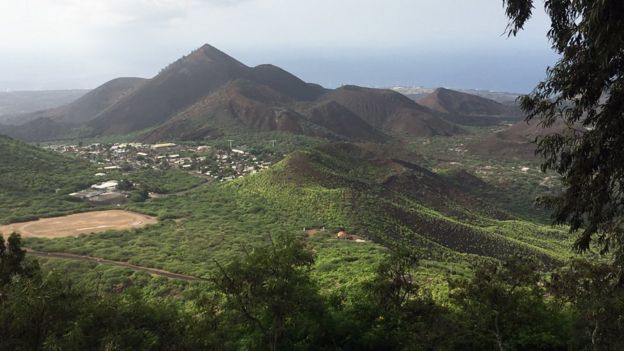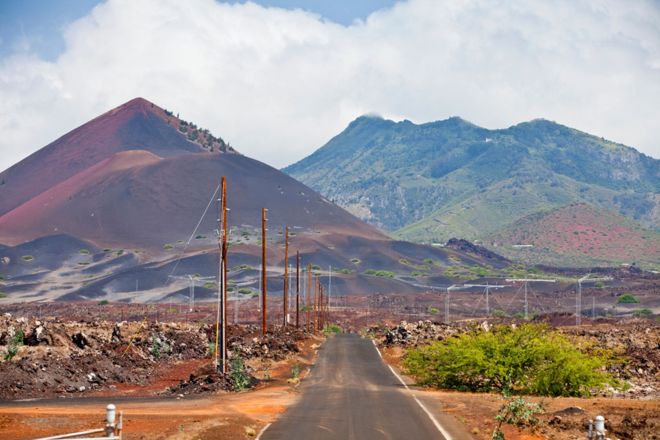Ascension from a bare rock in the ocean to cloud forest, Western impacts on Ascension Island
The wisdom of settling and eventually garrisoning Ascension Island is often elusive. This tiny, wind ravaged British outpost in Atlantic is a fascinating place. Originally uninhabited, and sparsely covered by vegetation, it is now an important Anglo-American airfield, has a population of 806 and even has an artificial cloud forest. One of the most paramount reasons for studying history is to observe change over time, and there is no more poignant example than the island's ascension.
In 1501, the Portuguese navigator Afonso de Albuquerque
sighted the island on Ascension Day, hence its name. Dry and barren, the island had little appeal
for passing ships except for collecting fresh meat, and was not claimed for the
Portuguese Crown. Mariners could hunt for the numerous seabirds and the
enormous green turtles that laid their eggs on the sandy beaches. The
Portuguese also introduced goats as a potential source of meat for future
mariners.
Organised settlement of Ascension Island began in 1815, when
the British garrisoned it as a precaution after imprisoning Napoleon I on Saint
Helena to the southeast. On 22 October, the island was claimed for King George
III.
The location of the island made it a useful stopping-point
for ships and communications. The Royal Navy used the island as a victualling
station for ships, particularly those of the West Africa Squadron working
against the slave trade. A garrison of Royal Marines was based at Ascension
from 1823.
In 1836 the Beagle voyage visited Ascension. Charles Darwin
described it as an arid treeless island, with nothing growing near the coast.
Sparse vegetation inland supported "about six hundred sheep, many goats, a
few cows & horses", large numbers of guineafowl imported from the Cape
Verde islands, rats, mice, and land crabs; he agreed with the saying attributed
to the people of St Helena that "We know we live on a rock, but the poor
people at Ascension live on a cinder".
In 1843, botanist and explorer Joseph Hooker visited the
island. Four years later, Hooker, with much encouragement from Darwin, advised
the Royal Navy that with the help of Kew Gardens, they should institute a
long-term plan of shipping trees to Ascension. The planted trees would capture
more rain and improve the soil, allowing the barren island to become a garden.
So, from 1850 and continuing year on year, ships came with an assortment of
plants from botanical gardens in Argentina, Europe and South Africa. By the
late 1870s Norfolk pines, eucalyptus, bamboo, and banana trees grew in
profusion at the highest point of the island, Green Mountain, creating a tropical
cloud forest.
 |
| the artificial cloud forest |
In 1899, the Eastern Telegraph Company installed the first
underwater cable from the island, connecting the UK with its colonies in South
Africa. In 1922, letters patent made
Ascension a dependency of Saint Helena. The
island was managed by the head of the Eastern Telegraph Company on the island
until 1964 when the British Government appointed an Administrator to represent
the Governor of Saint Helena on Ascension.
During World War II, to supply and augment extensive
amphibious aircraft antisubmarine patrol operations ongoing from the early days
of the war, the United States built an airbase on Ascension Island, known as
"Wideawake".
The airfield was used by the US military as a stopping point
for American aircraft crossing the Atlantic Ocean on the way to theatres of operation
in Europe and Africa. After the end of World War II, and American departure,
the airbase fell into disuse until in 1982, the British task force used
Ascension Island as a staging post during the Falklands War. The Royal Air
Force deployed a fleet of Vulcan bombers and Victor tankers at the airfield.
Vulcans launched the opening shots of the British offensive from Ascension in
Operation Black Buck. The RAF also used the base to supply the task force.
Because of the increase in air traffic during the war, Wideawake, with up to
400 movements of all types each day, was one of the busiest airfields in the
world for a short period. The Royal Navy's fleet stopped at Ascension for
refuelling on the way. Following the war, the British retained an increased
presence on the island, establishing RAF Ascension Island, and providing a
refuelling stop.
 |
| RAF Ascension Island |

Comments
Post a Comment